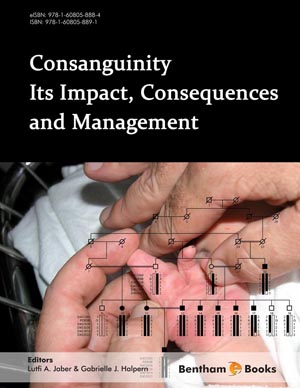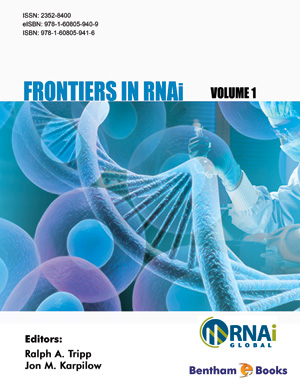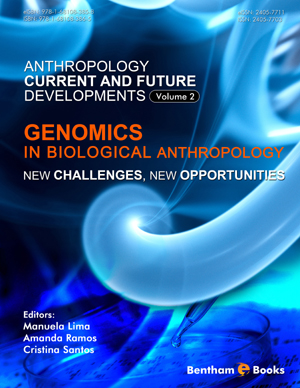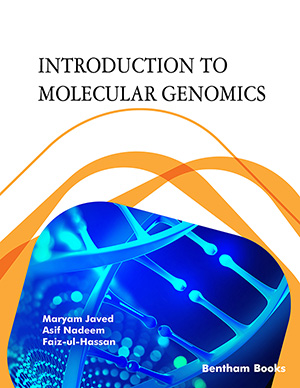Book Volume 2
Pharmacogenetics of Rheumatoid Arthritis and Spondyloarthropathies
Page: 3-27 (25)
Author: Ignacio Rego-Pérez, Natividad Oreiro-Villar, Carlos Fernández-López, Jose-Luis Fernández-Sueiro and Francisco J. Blanco
DOI: 10.2174/9781608057566113020003
PDF Price: $15
Abstract
Rheumatoid arthritis (RA), ankylosing spondylitis (AS) and psoriatic arthritis (PsA) are chronic and systemic diseases with an important inflammatory component and differing manifestations, all causing a significant decline in the quality of life of patients. RA produces bone and cartilage destruction, as well as a wide variety of extra-articular manifestations; AS mainly affects joints in the spine and sacroilium in the pelvis, and can cause eventual fusion of the spine; and PsA is an inflammatory arthritis associated with psoriasis.
These diseases are characterized by an unknown aetiology as well as a strong genetic contribution, supported by evidence from family and twin studies, linkage studies and population-based association studies. Proinflammatory cytokines, such as tumour necrosis factor-α (TNF-α) and several interleukins (IL-1, IL-6, IL-12) mediate the pathogeneses of these diseases. The human leukocyte antigen (HLA) region has been consistently associated with autoimmune pathologies, with HLA-DR mainly associated with RA and HLA-B27 with both AS and PsA.
These chronic inflammatory diseases are highly heterogeneous in all their aspects, including drug efficacy and toxicity in individual patients. A substantial proportion of patients do not respond efficiently to classical therapies and/or experience toxicity limiting further treatment, both of which lead to progression of inflammation. This high inter-individual variability in drug response and toxicity gives rise to the need to individualize and optimize therapy with anti-rheumatic agents, such as DMARDs [i.e., Methotrexate (MTX) and biological agents (i.e., anti-TNF agents)]. Studies in the field of pharmacogenetics are necessary to identify potential markers associated with clinical response. To date, many polymorphisms in genes associated not only with the diseases, but also with drug-metabolizing enzymes, drug targets and transporters, have been analysed, showing in some cases conflicting results. The aim of this review is to describe the state of the art of pharmacogenetics in three important chronic inflammatory diseases, RA, AS and PsA.
One-Carbon Metabolism and Alzheimer’s Disease: The DNA Methylation Hypothesis
Page: 28-76 (49)
Author: Fabio Coppedè
DOI: 10.2174/9781608057566113020004
PDF Price: $15
Abstract
Increasing evidence supports a role for epigenetic modifications in AD pathogenesis. Folate metabolism, also known as one-carbon metabolism, is required for the production of S-adenosylmethionine (SAM), which is the major DNA methylating agent. AD individuals are characterized by decreased serum folate values, as well as increased plasma homocysteine (Hcy) levels, and there is indication of impaired DNA methylation potential (SAM/SAH levels) in AD tissues. Some polymorphisms of genes participating in one-carbon metabolism have been associated with AD risk and/or with folate, Hcy or vitamin B12 levels in AD individuals. However, it is not yet clear wheter impairments in one-carbon metabolism are causative of AD or rather a consequence of the disease. Studies in rodents and in neuroblastoma cell cultures have shown that dietary restrictions of folate and other B vitamins result in epigenetic modifications of AD related genes as well as altered production of enzymes involved in DNA methylation, and that SAM treatment is able to restore both methylation and expression levels of those genes. Exposure to lead (Pb) resulted in epigenetic modification of AD related genes in rodents, monkeys and cell cultures. Moreover the amyloid-beta peptide itself possesses epigenetic properties. A few studies have been performed in human postmortem specimens, suggesting that some genes might be epigenetically modified within the disease pathogenesis. This chapter focuses on the current knowledge on DNA methylation in AD tissues, cell cultures and animal models.
Mechanisms and Signals for the Nuclear Import of Proteins
Page: 77-100 (24)
Author: Natália Freitas and Celso Cunha
DOI: 10.2174/9781608057566113020005
PDF Price: $15
Abstract
In eukaryotes, the nuclear membrane provides a physical barrier to the passive diffusion of macromolecules from and into the cytoplasm. Nucleocytoplasmic traffic occurs through highly specialized structures known as nuclear pores, and involves the participation of a special class of transport proteins. Active transport across the nuclear pores is an energy-dependent process that relies on the activity of Ran- GTPases both in the nuclear and cytoplasmic compartments.
Nuclear import of proteins is an essential step in regulating gene expression and the replication cycle of several viruses. In this review, the key mechanisms, pathways, and models underlying the transport of proteins across nuclear pores are analysed.
Cancer Proneness in Nijmegen Breakage Syndrome Carriers
Page: 101-119 (19)
Author: Alessandra di Masi, Francesco Berardinelli, Domenica Cilli and Antonio Antoccia
DOI: 10.2174/9781608057566113020006
PDF Price: $15
Abstract
Biallelic mutations in the NBN gene are responsible for the Nijmegen breakage syndrome (NBS), a rare autosomal recessive disorder characterized by chromosome instability and hypersensitivity to ionising radiation (IR). Epidemiological data evidence that the NBN gene can be considered a susceptibility factor for cancer development, as demonstrated by the fact that almost 40% of NBS patients have developed a malignancy before the age of 21. Interestingly, also NBN heterozygotes, which are clinically asymptomatic, display an elevated risk to develop some types of malignant tumours, especially breast, prostate and colorectal cancers, lymphoblastic leukaemia, and non-Hodgkin’s lymphoma (NHL). So far, nine mutations in the NBN gene have been found, at the heterozygous state, in cancer patients. Among them, the 657del5, the I171V and the R215W mutations are the most frequently described. The pathogenicity of these mutations is presumably connected with their occurrence in the highly conserved BRCT tandem domains of the NBN protein, which are present in a large superfamily of proteins and are recognized as major mediators of processes related to cell-cycle checkpoints and DNA repair. This review will focus on the current stateof- knowledge regarding the correlation between carriers of NBN gene mutations and the proneness to the development of malignant tumours.
Alternative Splicing and Tumor Progression
Page: 120-154 (35)
Author: Claudia Ghigna, Cristina Valacca and Giuseppe Biamonti
DOI: 10.2174/9781608057566113020007
PDF Price: $15
Abstract
Alternative splicing is a key molecular mechanism for increasing the functional diversity of the eukaryotic proteomes. A large body of experimental data implicates aberrant splicing in various human diseases, including cancer. Both mutations in cis-acting splicing elements and alterations in the expression and/or activity of splicing regulatory factors drastically affect the splicing profile of many cancer-associated genes. In addition, the splicing profile of several cancer-associated genes is altered in particular types of cancer arguing for a direct role of specific splicing isoforms in tumor progression. Deciphering the mechanisms underlying aberrant splicing in cancer may prove crucial to understand how splicing machinery is controlled and integrated with other cellular processes, in particular transcription and signaling pathways. Moreover, the characterization of splicing deregulation in cancer will lead to a better comprehension of malignant transformation. Cancer-associated alternative splicing variants may be new tools for the diagnosis and classification of cancers and could be the targets for innovative therapeutical interventions based on highly selective splicing correction approaches.
Role of HMGB Proteins in Coordinating Ribosomal Protein and Ribosomal RNA
Page: 155-175 (21)
Author: LiJuan Xiao and Anne Grove
DOI: 10.2174/9781608057566113020008
PDF Price: $15
Abstract
Cells grow in response to nutrients or growth factors, whose presence is detected and communicated by elaborate signaling pathways. Protein kinases play crucial roles in processes such as cell cycle progression and gene expression, and misregulation of such pathways has been correlated with various diseased states. Signals intended to promote cell growth converge on ribosome biogenesis, as the ability to produce cellular proteins is intimately tied to cell growth. Part of the response to growth signals is therefore the coordinate expression of genes encoding ribosomal RNA (rRNA) and ribosomal proteins (RP). A key player in regulating cell growth is the Target of Rapamycin (TOR) kinase, one of the gatekeepers that prevent cell cycle progression from G1 to S under conditions of nutritional stress. TOR is structurally and functionally conserved in all eukaryotes. Under favorable growth conditions, TOR is active and cells maintain a robust rate of ribosome biogenesis, translation initiation and nutrient import. Under stress conditions, TOR signaling is suppressed, leading to cell cycle arrest, while the failure of TOR to respond appropriately to environmental or nutritional signals leads to uncontrolled cell growth. Emerging evidence from Saccharomyces cerevisiae indicates that High Mobility Group (HMGB) proteins, nonsequence- specific chromosomal proteins, participate in mediating responses to growth signals. As HMGB proteins are distinguished by their ability to alter DNA topology, they frequently function in the assembly of higher-order nucleoprotein complexes. We review here recent evidence, which suggests that HMGB proteins may function to coordinate TOR-dependent regulation of rRNA and RP gene expression.
Databases and Web-Tools for Gene Expression Analysis in Arabidopsis thaliana
Page: 176-193 (18)
Author: Reinhard Hehl, Julio C. Bolívar, Jeannette Koschmann, Yuri Brill and Lorenz Bülow
DOI: 10.2174/9781608057566113020009
PDF Price: $15
Abstract
The number of internet resources for gene expression analysis in Arabidopsis thaliana has increased tremendously during the last years. These resources permit the database-assisted identification of putative cis-regulatory DNA sequences, their binding proteins, and the determination of common cis-regulatory motifs in coregulated genes. Also, genes targeted by inhibitory RNA can be identified with databases and webservers. DNA-binding proteins may be predicted by the type of cis-regulatory motif. Further questions of combinatorial control based on the interaction of DNA-binding proteins and the colocalization of cis-regulatory motifs can be addressed. The databaseassisted spatial and temporal expression analysis of DNA-binding proteins and their target genes may help to further refine experimental approaches. Signal transduction pathways upstream of regulated genes are beginning to be accessible in databases. This review focuses on the use of the AthaMap and PathoPlant databases for gene expression regulation analysis and discusses similar and complementary online databases and webtools. Online databases are helpful for the development of working hypothesis and for designing subsequent experiments.
Genetical Genomics of Plants: From Genotype to Phenotype
Page: 194-220 (27)
Author: Ronny V.L. Joosen, Wilco Ligterink, Henk W.M. Hilhorst and Joost J.B. Keurentjes
DOI: 10.2174/9781608057566113020010
Abstract
Natural variation provides a valuable resource to study the genetic regulation of quantitative traits. In quantitative trait locus (QTL) analyses this variation, captured in segregating mapping populations, is used to identify the genomic regions affecting these traits. The identification of the causal genes underlying QTLs is a major challenge for which the detection of gene expression differences is of major importance. By combining genetics with large scale expression profiling (i.e., genetical genomics), resulting in expression QTLs (eQTLs), great progress can be made in connecting phenotypic variation to genotypic diversity. In this review we discuss examples from human, mouse, Drosophila, yeast and plant research to illustrate the advances in genetical genomics, with a focus on understanding the regulatory mechanisms underlying natural variation. With their tolerance to inbreeding, short generation time and ease to generate large families, plants are ideal subjects to test new concepts in genetics. The comprehensive resources which are available for Arabidopsis make it a favorite model plant but genetical genomics also found its way to important crop species like rice, barley and wheat. We discuss eQTL profiling with respect to cis and trans regulation and show how combined studies with other ‘omics’ technologies, such as metabolomics and proteomics may further augment current information on transcriptional, translational and metabolomic signaling pathways and enable reconstruction of detailed regulatory networks. The fast developments in the ‘omics’ area will offer great potential for genetical genomics to elucidate the genotypephenotype relationships for both fundamental and applied research.
Expanded CTG Repeat Induced Molecular Alterations in Myotonic Dystrophy
Page: 221-245 (25)
Author: Beatriz Llamusí, Ariadna Bargiela and Ruben Artero
DOI: 10.2174/9781608057566113020011
PDF Price: $15
Abstract
Myotonic Dystrophy type 1 (DM1) is a multi-system disorder characterised by muscle wasting, myotonia, cardiac conduction defects, cataracts, and neuropsychological dysfunction. DM1 is caused by expansion of a CTG repeat in the 3´ untranslated region (UTR) of the Dystrophia Myotonica Protein Kinase (DMPK) gene. A body of work demonstrates that DMPK mRNAs containing abnormally expanded CUG repeats are toxic to several cell types. A core mechanism underlying symptoms of DM1 is that mutant DMPK RNA interferes with the developmentally regulated alternative splicing of defined pre-mRNAs by altering the function of important splicing regulators such as MBNL1, CELF1 and hnRNP H. However, other RNA metabolism pathways have also been found to be altered in DM1. Bidirectional transcription allows generation of poly-CAG and poly-CUG mRNAs, both of which can generate toxic polyaminoacidic proteins by Repeat Associated Non-ATG (RAN) translation. Double stranded RNAs (CAG)•(CUG) and CUG expansion hairpins might act as Dicer ribonuclease targets, thus leading to silencing of transcripts containing complementary sequences. Upon transcription, mutant DMPK RNA coexists as ssCUG and dsCUG forming hairpins. CELF1 accumulates in the nucleus and binds to ssCUG while MBNL1 is sequestered in hairpins, thus altering their activity as splicing factors. ssCUG also binds different types of nuclear factors such as transcription factors, contributing to gene transcription deficiencies. More recently, several microRNAs have also been found to be altered in DM1 affected muscles. In summary, mutant DMPK transcripts have been shown to alter gene transcription, translation and alternative splicing of specific gene transcripts, and have the ability to trigger gene-specific silencing effects and microRNA dysregulation in DM1 cells. Therapies aimed at reversing these gene expression alterations are likely to be effective ways to treat DM1.
Saturation of the Human Phenome
Page: 246-296 (51)
Author: Mark E. Samuels
DOI: 10.2174/9781608057566113020012
PDF Price: $15
Abstract
The phenome is the complete set of phenotypes resulting from genetic variation in populations of an organism. Saturation of a phenome implies the identification and phenotypic description of mutations in all genes in an organism, potentially constrained to those encoding proteins. The human genome is believed to contain 20-25,000 protein coding genes, but only a small fraction of these have documented mutant phenotypes, thus the human phenome is far from complete. In model organisms, genetic saturation entails the identification of multiple mutant alleles of a gene or locus, allowing a consistent description of mutational phenotypes for that gene. Saturation of several model organisms has been attempted, usually by targeting annotated coding genes with insertional transposons (Drosophila melanogaster, Mus musculus) or by sequence directed deletion (Saccharomyces cerevisiae) or using libraries of antisense oligonucleotide probes injected directly into animals (Caenorhabditis elegans, Danio rerio). This paper reviews the general state of the human phenome, and discusses theoretical and practical considerations toward a saturation analysis in humans. Throughout, emphasis is placed on high penetrance genetic variation, of the kind typically asociated with monogenic versus complex traits.
Malaria Functional Genomics and Beyond
Page: 297-323 (27)
Author: Jianbing Mu, Karl B. Seydel, Adam Bates, Junhui Duan, Lubin Jiang and Xin-zhuan Su
DOI: 10.2174/9781608057566113020013
PDF Price: $15
Abstract
With the completion and near completion of many malaria parasite genomesequencing projects, efforts are now being directed toward a better understanding of gene functions and discovery of vaccine and drug targets. Novel biologic pathways present in the parasite have been identified through homology searches and inter- and intra-species comparison of the parasite genome. Genetic mapping approaches, including linkage and population association analyses, have provided valuable insights into parasite evolution, virulence, drug resistance, and immune invasion. Genome-wide searches for loci under various selection pressures have lead to discovery of parasite genetic loci or genes playing a role in drug resistance or encoding for protective antigens. In addition, the Plasmodium falciparum genome sequence provides the basis for the development of various microarrays to monitor gene expression and to detect nucleotide substitution and deletion/amplification, for genome-wide profiling of the parasite proteome, and for investigation of epigenetic regulation of gene expression such as chromatin modification, and nucleosome position. In this brief review, we will highlight some recent advances and studies in characterizing gene function and related phenotype in P. falciparum that were made possible by the genome sequence, particularly the development of a genome-wide diversity map and various high-throughput genotyping methods for genome-wide association studies.
Introduction
Genome science or genomics is essential to advancing knowledge in the fields of biology and medicine. Specifically, researchers learn about the molecular biology behind genetic expression in living organisms and related methods of treating human genetic diseases (including gene therapy). Advances in Genome Science is an e-book series which provides a multi-disciplinary view of some of the latest developments in genome research, allowing readers to capture the essentiality and diversity of genomics in contemporary science. The second volume of this ebook series contains a selection of articles on intracellular gene regulation and expression in human disease such as arthritis, Alzheimer’s disease, Nijmegen Breakage Syndrome, Tumors and Malaria among other diseases. The volume also features some chapters on plant genetics


















